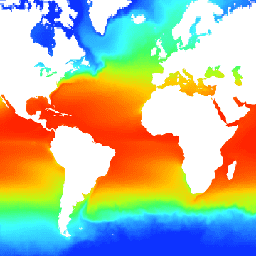
- 데이터 세트 제공
- 1981-09-01T00:00:00Z–2025-12-15T00:00:00Z
- 데이터 세트 제공업체
- NOAA
- 주기
- 1일
- 태그
설명
NOAA 1/4도 일일 최적 보간 해수면 온도(OISST)는 다양한 플랫폼 (위성, 선박, 부표)에서 편향 조정된 관측치를 정규 전역 그리드에 결합하여 구성된 완전한 해양 온도 필드를 제공하며, 간격은 보간으로 채워집니다. Advanced Very High Resolution Radiometer (AVHRR)의 위성 데이터는 1981년 말부터 현재까지 높은 시간-공간 범위를 허용하는 주요 입력을 제공합니다.
OISST 데이터 세트에는 하루의 데이터가 두 번 처리되어 있습니다. 먼저 1일의 지연 시간이 있는 거의 실시간 예비 버전이 출시되고 14일의 지연 시간이 있는 최종 버전이 출시됩니다. 최종 버전은 예비 버전을 대체하는 것 외에도 스무딩을 위한 추가 일수와 구역 편향 보정을 사용합니다.
대역
픽셀 크기
27,830미터
대역
| 이름 | 단위 | 최소 | 최대 | 축적 | 픽셀 크기 | 설명 |
|---|---|---|---|---|---|---|
sst |
°C | -180* | 3764* | 0.01 | 미터 | 일일 해수면 온도 |
anom |
°C | -1887* | 1902* | 0.01 | 미터 | 온도 이상치: 일일 OISST에서 30년 기후학적 평균을 뺀 값입니다. |
ice |
% | 1* | 100* | 0.01 | 미터 | 일일 해빙 농도의 7일 중앙값입니다. |
err |
°C | 11* | 171* | 0.01 | 미터 | 추정 오류입니다. 분석된 해수면 온도의 표준 편차입니다. |
이미지 속성
이미지 속성
| 이름 | 유형 | 설명 |
|---|---|---|
| 상태 | 문자열 | 'provisional' 또는 'permanent' |
이용약관
이용약관
CDR의 NOAA CDR 프로그램 공식 배포 지점은 NOAA의 국립 기후 데이터 센터로, '개방형 데이터 정책'에 관한 대통령 각서에 설명되고 2013년 5월 9일 행정 명령 '정부 정보의 새로운 기본값으로 개방형 및 기계 판독 가능 설정'에 따라 CDR 패키지 및 관련 정보에 대한 지속적이고 개방적인 액세스와 적극적인 데이터 관리를 제공합니다. 이러한 정책에 따라 CDR 데이터 세트는 독점적이지 않고 공개적으로 제공되며 사용에 제한이 없습니다. 자세한 내용은 NOAA의 CDR 데이터 세트, 알고리즘, 문서의 공정 사용 PDF를 참고하세요.
인용
리처드 W. Reynolds, Viva F. Banzon, NOAA CDR 프로그램 (2008): NOAA 최적 보간 1/4도 일일 해수면 온도 (OISST) 분석, 버전 2. [사용된 하위 집합을 표시] NOAA National Centers for Environmental Information. doi:10.7289/V5SQ8XB5[액세스 날짜].
DOI
Earth Engine으로 탐색
코드 편집기(JavaScript)
var dataset = ee.ImageCollection('NOAA/CDR/OISST/V2_1') .filter(ee.Filter.date('2017-05-01', '2017-05-14')); var seaSurfaceTemperature = dataset.select('sst'); var visParams = { min: -180.0, max: 3000.0, palette: [ '040274', '040281', '0502a3', '0502b8', '0502ce', '0502e6', '0602ff', '235cb1', '307ef3', '269db1', '30c8e2', '32d3ef', '3be285', '3ff38f', '86e26f', '3ae237', 'b5e22e', 'd6e21f', 'fff705', 'ffd611', 'ffb613', 'ff8b13', 'ff6e08', 'ff500d', 'ff0000', 'de0101', 'c21301', 'a71001', '911003' ], }; Map.setCenter(20.3, -20.39, 2); Map.addLayer(seaSurfaceTemperature, visParams, 'Sea Surface Temperature');
